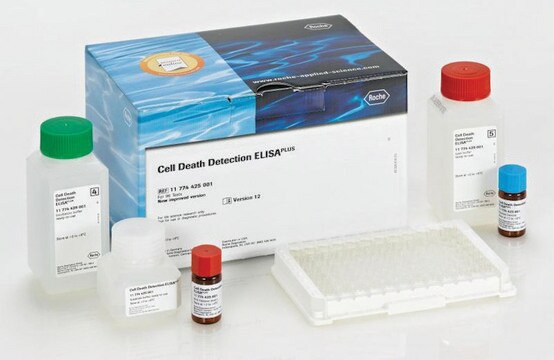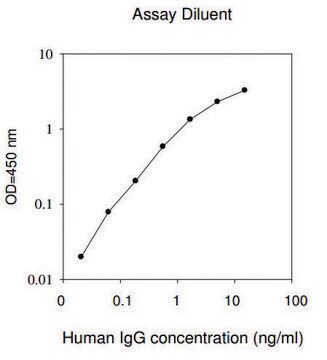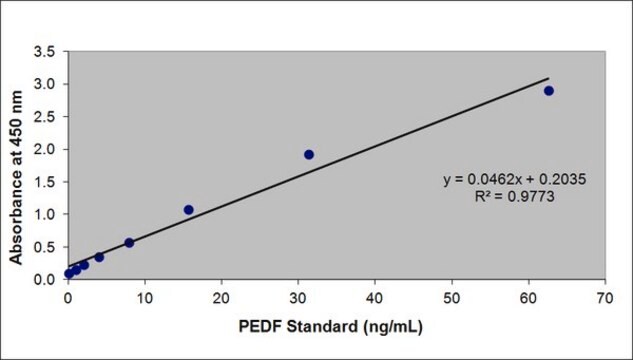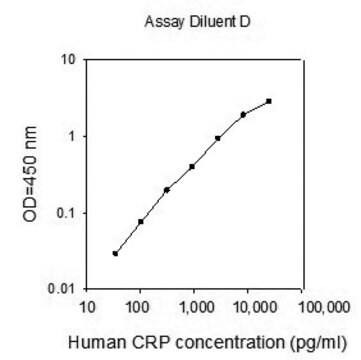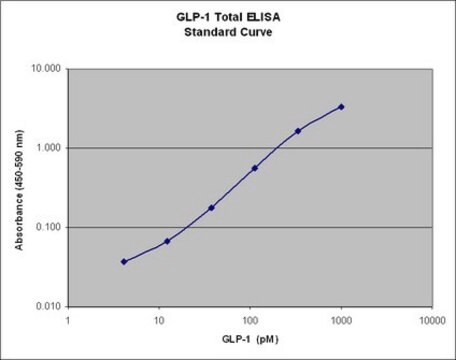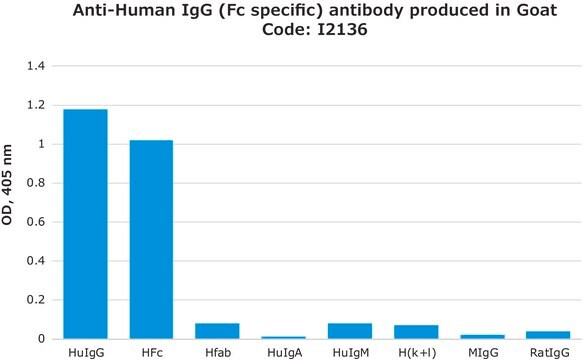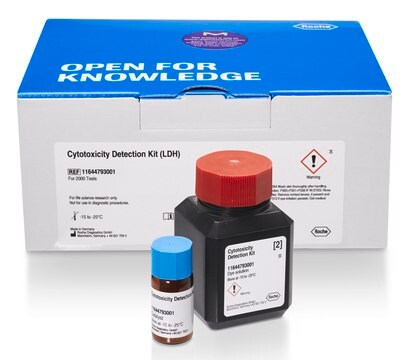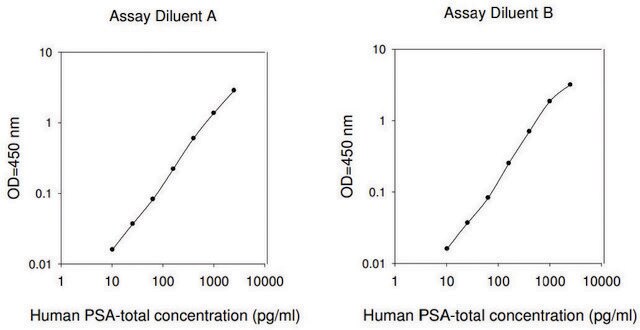11585878001
Roche
hGH ELISA
sufficient for 192 tests, >98% (SDS-PAGE), kit of 1, suitable for ELISA
Synonim(y):
ELISA
Zaloguj sięWyświetlanie cen organizacyjnych i kontraktowych
About This Item
Kod UNSPSC:
41116158
Polecane produkty
Próba
>98% (SDS-PAGE)
zastosowanie
sufficient for 192 tests
opakowanie
kit of 1
producent / nazwa handlowa
Roche
metody
ELISA: suitable
temp. przechowywania
2-8°C
Opis ogólny
Human growth hormone (hGH) is specifically detected by the hGH ELISA. It does not cross-react with rat growth hormone. Cross-reactivity with the human homologues TSH, FSH, and LH has not been tested. The hGH protein from E. coli, included in the kit for the purpose of compiling a standard calibration curve, is provided with lot-specific content data as determined by immunoassay.
hGH Standards
The hGH protein from E. coli, included in the kit for the purpose of compiling a standard calibration curve, is provided with lot-specific content data as determined by immunoassay.
hGH Standards
The hGH protein from E. coli, included in the kit for the purpose of compiling a standard calibration curve, is provided with lot-specific content data as determined by immunoassay.
The hGH assay system differs from most of the other commonly used reporter proteins (CAT, β-Gal, or luciferase) in one important respect: hGH is a secreted protein, and is measured using samples of culture-medium supernatants thus (i) avoiding the necessity to lyse cells, (ii) allowing continuous monitoring of transient expression kinetics, and (iii) allowing use of the cells for other purposes (e.g., RNA isolation). Additionally, hGH is a mammalian gene that may contribute to the apparent high stability of the hGH mRNA in most mammalian cells.
Using the standard isotopic protocol, secretion of hGH protein into the culture-medium supernatant can be monitored approximately 24hours post-transfection, depending on the cell type and the sensitivity of the assay used. Usually, hGH is quantified by an immunoradiometric assay (IRMA), resulting in a linear range of approximately 0.1 to 50ng hGH/ml.
Using the standard isotopic protocol, secretion of hGH protein into the culture-medium supernatant can be monitored approximately 24hours post-transfection, depending on the cell type and the sensitivity of the assay used. Usually, hGH is quantified by an immunoradiometric assay (IRMA), resulting in a linear range of approximately 0.1 to 50ng hGH/ml.
Specyficzność
The hGH ELISA specifically detecs human growth hormone (hGH). It does not cross-react with rat growth hormone.
Zastosowanie
For research use only. Not for use in diagnostic procedures.
The hGH ELISA is used to quantitatively measure the expression level of hGH released into cell culture supernatant of eukaryotic cells transfected with a plasmid containing a reporter gene that encodes for hGH.
The hGH ELISA is used to quantitatively measure the expression level of hGH released into cell culture supernatant of eukaryotic cells transfected with a plasmid containing a reporter gene that encodes for hGH.
Cechy i korzyści
- Standardized: Allows direct comparison of data from different sets of experiments, even when kits from different production lots are used
- More sensitive: The hGH ELISA is approximately 20-times more sensitive than isotopic hGH assays
- More specific: The hGH ELISA shows no crossreactivity with rat growth hormone
- Faster: Measures hGH expression as early as 18hours post-transfection and requires only approximately 4 hours from start to finish
- Easy to perform: Follows a standard ELISA protocol
Opakowanie
1 kit containing 9 components.
Charakterystyka techniczna
Assay time: Approximately 4 hours
Sample material: Culture supernatant
Sensitivity: ≥5pg/ml (≥1pg/well)
Standards: The hGH protein from E. coli, included in the kit for the purpose of compiling a standard calibration curve, is provided with lot-specific content data as determined by immunoassay.
Sample material: Culture supernatant
Sensitivity: ≥5pg/ml (≥1pg/well)
Standards: The hGH protein from E. coli, included in the kit for the purpose of compiling a standard calibration curve, is provided with lot-specific content data as determined by immunoassay.
Zasada
The hGH ELISA is based on the sandwich ELISA principle. Antibodies to hGH (anti-hGH) are prebound to the surface of the microplate. The culture supernatant, which contains secreted hGH, is added to the wells of the microplate modules. All hGH contained in the medium binds to the anti-hGH bound to the microplate surface. Next, a digoxigenin-labeled antibody to hGH (anti-hGH-DIG) is added, then bound to hGH. In the following step, an antibody to digoxigenin conjugated to peroxidase (anti-DIG-POD) is added, then bound to digoxigenin. In the final step, the peroxidase substrate ABTS is added. The peroxidase enzyme catalyzes the cleavage of the substrate, yielding a colored reaction product. The absorbance of the sample is determined using an ELISA reader, and is directly correlated to the level of hGH present in the medium supernatant. The sensitivity of the assay can be enhanced using the peroxidase substrate (ABTS) with substrate enhancer.
Uwaga dotycząca przygotowania
Working solution: Solution 1 hGH Stock Solution (bottle 1)
Reconstitute the lyophilizate in 0.5 ml double distilled water. The resulting concentration is calculated using the lot-specific information, given on the label (final conc. approx 10 ng/ml). This solution is used for the preparation of hGH standards for establishing a hGH calibration curve (see 7.2: preparation of hGH standards).
Solution 2 Anti-hGH-DIG (bottle 2)
Reconstitute the lyophilizate in 0.5 ml double distilled water (final conc. 100 μg/ml).
Solution 2a Anti-hGH-DIG, working dilution
To prepare anti-hGH-DIG working dilution, dilute the reconstituted anti-hGH-DIG solution (100 g/ml) with sample buffer (solution 7) to a final conc. of 1 μg/ml (e.g., 100 μl of reconstituted anti-hGH-DIG solution 9.9 ml of solution 7 for 50 wells).The working dilution should be prepared freshly before use and should not be stored.
Solution 3 Anti-DIG-POD (bottle 3)
Reconstitute the lyophilizate in 0.5 ml double distilledwater (final conc. 20 U/ml). Do not add sodiumazide!
Solution 3a Anti-DIG-POD, working dilution
To prepare anti-DIG-POD, working dilution, dilute the reconstituted anti-DIG-POD solution (20 U/ml) with sample buffer (solution 7) to a final conc. of 200 mU/ml (e.g., 100 μl of reconstituted anti-DIG-POD solution 9.9 ml of solution 7 for 50 wells). The working dilution should be prepared freshly before use and should not be stored.
Solution 4 POD Substrate (bottle 4)
Ready-to-use solution.
Solution 5 POD Substrate containing Substrate Enhancer (bottles 4 and 5)
If a low hGH concentration in the sample is expected, add 1 mg of substrate enhancer (bottle 5) per ml of solution 4 and mix by stirring for 30 min at 15 to 25 °C. The solution is stable for only 2 hours and should therefore be prepared immediately before use. Use the substrate enhancer only if the hGH concentration is low!
Solution 6 Washing Buffer, 1× (bottle 6)
To prepare a ready-to-use washing buffer, mix 1 part 10x washing buffer concentrate (bottle 6) with 9 parts of double distilled water.
Solution 7 Sample Buffer (bottle 7)
The solution is ready-to-use. Mix thoroughly before use. Do not add sodium azide.
Storage conditions (working solution): Solution 1 hGH Stock Solution (bottle 1)
The reconstitutedsolution is stable for 2 months at 2 to 8 °C. For long term storage, store in aliquots at or below -15 to -25 °C.
Solution 2 Anti-hGH-DIG (bottle 2)
The reconstituted solution is stable for two months at 2 to 8 °C. For long term storage, store in aliquots at or below -15 to -25 °C.
Solution 2a Anti-hGH-DIG, working dilution
The working dilution should be prepared freshly before use and should not be stored.
Solution 3 Anti-DIG-POD (bottle 3)
The reconstituted solution is stable for 6 months at 2 to 8 °C. Do not freeze!
Solution 3a Anti-DIG-POD, working dilution
The working dilution should be prepared freshly before use and should not be stored.
Solution 4 POD Substrate (bottle 4)
The solution is stable until the expiration date given on the label if stored at 2 to 8 °C.
POD Substrate containing Substrate Enhancer (bottles 4 and 5)
The solution is stable for only 2 hours and should therefore be prepared immediately before use.
Solution 6 Washing Buffer, 1× (bottle 6)
The reconstituted solution is stable for 6 months at 2 to 8 °C.
Solution 7 Sample Buffer (bottle 7)
After opening the bottle we recommend storing the solution in aliquots at -15 to -25 °C, since it does not contain a preservative agent.
Reconstitute the lyophilizate in 0.5 ml double distilled water. The resulting concentration is calculated using the lot-specific information, given on the label (final conc. approx 10 ng/ml). This solution is used for the preparation of hGH standards for establishing a hGH calibration curve (see 7.2: preparation of hGH standards).
Solution 2 Anti-hGH-DIG (bottle 2)
Reconstitute the lyophilizate in 0.5 ml double distilled water (final conc. 100 μg/ml).
Solution 2a Anti-hGH-DIG, working dilution
To prepare anti-hGH-DIG working dilution, dilute the reconstituted anti-hGH-DIG solution (100 g/ml) with sample buffer (solution 7) to a final conc. of 1 μg/ml (e.g., 100 μl of reconstituted anti-hGH-DIG solution 9.9 ml of solution 7 for 50 wells).The working dilution should be prepared freshly before use and should not be stored.
Solution 3 Anti-DIG-POD (bottle 3)
Reconstitute the lyophilizate in 0.5 ml double distilledwater (final conc. 20 U/ml). Do not add sodiumazide!
Solution 3a Anti-DIG-POD, working dilution
To prepare anti-DIG-POD, working dilution, dilute the reconstituted anti-DIG-POD solution (20 U/ml) with sample buffer (solution 7) to a final conc. of 200 mU/ml (e.g., 100 μl of reconstituted anti-DIG-POD solution 9.9 ml of solution 7 for 50 wells). The working dilution should be prepared freshly before use and should not be stored.
Solution 4 POD Substrate (bottle 4)
Ready-to-use solution.
Solution 5 POD Substrate containing Substrate Enhancer (bottles 4 and 5)
If a low hGH concentration in the sample is expected, add 1 mg of substrate enhancer (bottle 5) per ml of solution 4 and mix by stirring for 30 min at 15 to 25 °C. The solution is stable for only 2 hours and should therefore be prepared immediately before use. Use the substrate enhancer only if the hGH concentration is low!
Solution 6 Washing Buffer, 1× (bottle 6)
To prepare a ready-to-use washing buffer, mix 1 part 10x washing buffer concentrate (bottle 6) with 9 parts of double distilled water.
Solution 7 Sample Buffer (bottle 7)
The solution is ready-to-use. Mix thoroughly before use. Do not add sodium azide.
Storage conditions (working solution): Solution 1 hGH Stock Solution (bottle 1)
The reconstitutedsolution is stable for 2 months at 2 to 8 °C. For long term storage, store in aliquots at or below -15 to -25 °C.
Solution 2 Anti-hGH-DIG (bottle 2)
The reconstituted solution is stable for two months at 2 to 8 °C. For long term storage, store in aliquots at or below -15 to -25 °C.
Solution 2a Anti-hGH-DIG, working dilution
The working dilution should be prepared freshly before use and should not be stored.
Solution 3 Anti-DIG-POD (bottle 3)
The reconstituted solution is stable for 6 months at 2 to 8 °C. Do not freeze!
Solution 3a Anti-DIG-POD, working dilution
The working dilution should be prepared freshly before use and should not be stored.
Solution 4 POD Substrate (bottle 4)
The solution is stable until the expiration date given on the label if stored at 2 to 8 °C.
POD Substrate containing Substrate Enhancer (bottles 4 and 5)
The solution is stable for only 2 hours and should therefore be prepared immediately before use.
Solution 6 Washing Buffer, 1× (bottle 6)
The reconstituted solution is stable for 6 months at 2 to 8 °C.
Solution 7 Sample Buffer (bottle 7)
After opening the bottle we recommend storing the solution in aliquots at -15 to -25 °C, since it does not contain a preservative agent.
Komentarz do analizy
No cross-reaction with rat growth hormone. Cross reactivity with the human homologues TSH, FSH, and LH has not been tested.
Inne uwagi
For life science research only. Not for use in diagnostic procedures.
Ta strona może zawierać tekst przetłumaczony maszynowo.
Tylko elementy zestawu
Numer produktu
Opis
- hGH (human growth hormone)
- Anti-hGH-digoxigenin (anti-hGH-DIG) antibody, lyophilizate
- Anti-Digoxigenin-POD antibody, lyophilizate
- POD Substrate ready-to-use
- Substrate Enhancer
- Washing Buffer 10x concentrated
- Sample Buffer
- Microplates (24x8 wells), precoated with anti-hGH (2)
- Self-adhesive Plate Cover Foils (6)
Zobacz wszystko (9)
Hasło ostrzegawcze
Warning
Zwroty wskazujące rodzaj zagrożenia
Zwroty wskazujące środki ostrożności
Klasyfikacja zagrożeń
Aquatic Chronic 3 - Eye Irrit. 2 - Skin Sens. 1
Kod klasy składowania
12 - Non Combustible Liquids
Klasa zagrożenia wodnego (WGK)
WGK 3
Temperatura zapłonu (°F)
does not flash
Temperatura zapłonu (°C)
does not flash
Wybierz jedną z najnowszych wersji:
Masz już ten produkt?
Dokumenty związane z niedawno zakupionymi produktami zostały zamieszczone w Bibliotece dokumentów.
Jessica R Chaffey et al.
Scientific reports, 11(1), 15624-15624 (2021-08-04)
The generation of a human pancreatic beta cell line which reproduces the responses seen in primary beta cells, but is amenable to propagation in culture, has long been an important goal in diabetes research. This is particularly true for studies
Gabriela da Silva Xavier et al.
The Biochemical journal, 371(Pt 3), 761-774 (2003-02-19)
AMP-activated protein kinase (AMPK) has recently been implicated in the control of preproinsulin gene expression in pancreatic islet beta-cells [da Silva Xavier, Leclerc, Salt, Doiron, Hardie, Kahn and Rutter (2000) Proc. Natl. Acad. Sci. U.S.A. 97, 4023-4028]. Using pharmacological and
Woo-Jae Park et al.
Neuroscience letters, 444(3), 240-244 (2008-09-02)
Leucine-rich glioma inactivated 3 (LGI3) is a member of LGI/epitempin (EPTP) family. The biological function of LGI3 and its association with disease are not known. We previously reported that mouse LGI3 was highly expressed in brain in a developmentally and
Nasz zespół naukowców ma doświadczenie we wszystkich obszarach badań, w tym w naukach przyrodniczych, materiałoznawstwie, syntezie chemicznej, chromatografii, analityce i wielu innych dziedzinach.
Skontaktuj się z zespołem ds. pomocy technicznej